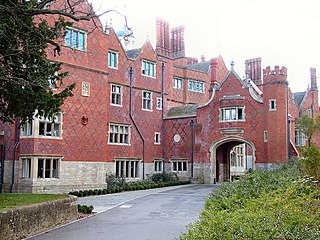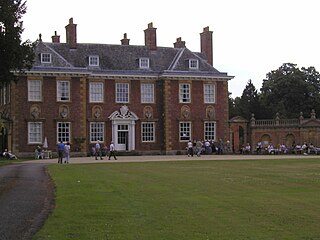
Ye Olde Cinder House is a house on Station Road in West Hallam, Derbyshire, and is made of cinder, a type of igneous rock similar to pumice. It has been a Grade II listed building since 1986. [1]

Ye Olde Cinder House is a house on Station Road in West Hallam, Derbyshire, and is made of cinder, a type of igneous rock similar to pumice. It has been a Grade II listed building since 1986. [1]
The Cinder House was built in 1833 to celebrate the birth of the local Squire's son, Francis Parker Newdigate. It was built from cinders which were made by burning pieces of clay that were dug from the nearby Mapperley Park in Mapperley. [2]
The date and initials of the Squire's son are visible under the eaves of the house in different colours of stone. It reads "FN" and "1833"
For many years the house was semi-detached, half of it belonging to the Leeson family. It was sold when Ethel Cheetham (née Leeson) had to move into an old people's home in the early 1990s. The family share was then sold to the neighbours who converted it into a single dwelling. It is believed to be unique.

Baddesley Clinton is a moated manor house, about 8 miles (13 km) north-west of the town of Warwick, in the village of Baddesley Clinton, Warwickshire, England. The house probably originated in the 13th century, when large areas of the Forest of Arden were cleared for farmland. The site is a Scheduled Ancient Monument and the house is a Grade I listed building. The house, park and gardens are owned by the National Trust and open to the public; they lie in a civil parish of the same name.

Boscobel House is a Grade II* listed building in the parish of Boscobel in Shropshire. It has been, at various times, a farmhouse, a hunting lodge, and a holiday home; but it is most famous for its role in the escape of Charles II after the Battle of Worcester in 1651. Today it is managed by English Heritage.
Totley is a suburb on the extreme southwest of the City of Sheffield, in South Yorkshire, England. Lying in the historic county boundaries of Derbyshire, Totley was amalgamated into the city of Sheffield in 1933, and is today part of the Dore and Totley electoral ward in the city, though it remains close to the contemporary county boundary of Derbyshire. Totley had a population of 7,963 in 2011. Totley was shown at the 2011 census as being part of the ward of Dore and Totley.

The Garden District is a neighborhood of the city of New Orleans, Louisiana, United States. A subdistrict of the Central City/Garden District Area, its boundaries as defined by the New Orleans City Planning Commission are: St. Charles Avenue to the north, 1st Street to the east, Magazine Street to the south, and Toledano Street to the west. The National Historic Landmark district extends a little farther.

Erddig Hall is a Grade-I listed National Trust property in Wrexham, Wales. Standing 2 miles (3.2 km) south of Wrexham city centre, it comprises a country house built during the 17th and 18th centuries amidst a 1,900 acre estate, which includes a 1,200-acre landscaped pleasure park and the earthworks of a Norman motte-and-bailey castle.

The Nutbrook Canal was a canal in England which ran between Shipley in Derbyshire and the Erewash Canal, joining it near Trowell. It was built to serve the collieries at Shipley and West Hallam, and was completed in 1796. It was initially profitable, but from 1846 faced competition from the railways, and more seriously, subsidence caused by the coal mines that it was built to serve. With the mines failing to pay tolls for goods carried on the canal, and in some cases refusing to accept responsibility for the subsidence, most of it was closed in 1895, although the final 1.5 miles (2.4 km) remained in use until 1949.

Mapperley is a residential and commercial area of north-eastern Nottingham, England. The area is bounded by Sherwood to the north-west, Thorneywood to the south and Gedling to the east.

Goldings Estate is a large Elizabethan style country house and surrounding land close to Waterford, north of Hertford, Hertfordshire, England. The house was designed by George Devey (1820–1886), constructed between 1871 and 1877, and is a Grade II* listed building.

Patshull Hall is a substantial Georgian mansion house situated near Pattingham in Staffordshire, England. It is a Grade I listed building and by repute is one of the largest listed buildings in the county.

Honington Hall is a privately owned 17th century country house at Honington, near Stratford on Avon, Warwickshire. It has Grade I listed building status.

Cradley Heath Baptist Church, also known as Four-ways Baptist Church, was the first Church of any denomination to build a chapel in Cradley Heath, West Midlands. The first meeting was in December 1833, in Grainger's Lane. Later, land was bought near the Four-Ways end of the High Street, and a meeting place was built. The site was expanded, and two further buildings were built, the last in 1904.

Bowcliffe Hall is located at Bramham near Wetherby, West Yorkshire, England. Built between 1805 and 1825, Bowcliffe Hall is a Grade II listed building now used as an office and event space. The building is constructed of ashlar limestone, under a shallow pitched slate roof to a rectangular double pile floor plan. It is mainly built across two storeys, although the East Wing has been modified to three.
Grace Dieu Manor is a 19th-century country house near Thringstone in Leicestershire, England, occupied by Grace Dieu Manor School until 2020. It is a Grade II listed building.

Fowelscombe is a historic manor in the parish of Ugborough in Devon, England. The large ancient manor house known as Fowelscombe House survives only as an ivy-covered "romantic ruin" overgrown by trees and nettles, situated 1 mile south-east of the village of Ugborough. The ruins are a Grade II listed building.

Oakes Park is a privately owned, historic park land in the green-belt area of south Sheffield. It contains 15 private homes as well as a 17th-century English country house which now operates as The Oakes Holiday Centre, a Christian, residential activity centre for young people between the ages of 8 and 18. It is set in extensive grounds which make it very difficult to be seen by the general public. It is situated on Norton Lane in the suburb of Norton within the City of Sheffield in England. The house is a Grade II* listed building, as are several other buildings and features.

Moseley Hall is a Grade II listed 18th-century country house which was situated in parkland in Moseley, Birmingham. The hall itself is now part of Moseley Hall Hospital and much of the surrounding estate has been developed for roads and housing.

Bradgate House is a 16th-century ruin in Bradgate Park, Leicestershire, England.

St Michael the Archangel is a Grade I listed church in Llanyblodwel, in Shropshire, England. It has a spire of unusual shape and was designed in 1847–1856 by the vicar, Rev. John Parker.

Madeley Court is a 16th-century country house in Madeley, Shropshire, England which was originally built as a grange to the medieval Wenlock Priory. It has since been restored as a hotel.
West Hallam is a civil parish in the Borough of Erewash in Derbyshire, England. The parish contains six listed buildings that are recorded in the National Heritage List for England. Of these, one is listed at Grade II*, the middle of the three grades, and the others are at Grade II, the lowest grade. The parish contains the village of West Hallam and the surrounding area. All the listed buildings are in the village, and consist of a church, two schools later used for other purposes, a pair of cottages, a war memorial, and a bottle kiln from a former pottery.